|
All
the nations that had alliance to Nazi Germany rendered military
awards to those soldiers that in one way or another provided heroic
service to their particular country, such awards are shown below.
The majority of foreigners receiving such awards were Germans.
As the war progress and countries changed alliance those awards
were removed such as with Romania and Finland.
Many of the Romanian Awards were beautifuly designed and crafted as you will see.
The Romanian Orders and Decorations were under the control of the
"Monetaria Nationala" (Monetary, National) in Bucharest. Many Orders and Decorations
were contracted to German firms such as: "Paul Telge, Berlin and C.F. Zimmermann, Pforzheim." | |
|
The Order was instituted
on 26 September 1916 (By Royal Decree No. 2968/1916) and was the most prestigious of all Romanian awards.
As a war decoration it was conferred on officers only for leadership in battle or bravery in the field.
During WWII it was re-instituted on 8 October 1941 and on 18 October 1944. 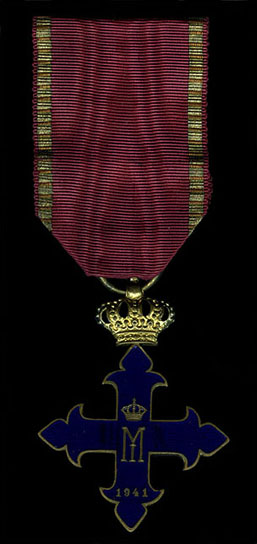

As indicated the 1944 model had two 57 mm swords added to the 1st and
2nd classes of the 1916 model and 38 mm swords to the 3rd class. The 1st class had on the obverse the crown and Michaels monogram.
The 2nd and 3rd classes had on the obverse the crown, Michaels monogram and the year 1944. | |
|
The
Order of the Crown of Romania "Ordin Corona Romaneii" was instituted
on 14 March 1881 on the day that Romania was proclaimed a kingdom
under King Carol I.
Five Classes were awarded: Grand Cross, Crand Officer, Commander, Officer,
Knight. The statutes and regulations of this Order are, however, dated 10th May
1881. This date is significant one in Romanian history, e.g. | |
|
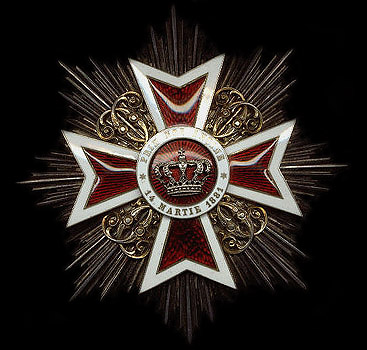
Above is a breathtaking rarely encountered example of the Romanian Grand Cross 1932 Civil Merit award. Only 200 Grand Crosses for Civil Merit and 50 for Military Merit were rendered. The Military Merit award had Crown attached on the top of the badge and for acts of bravery swords were added. This decoration has to be considered one of the finest awards ever crafted. This eight pointed breast star is huge measuring 87mm. At one time the breast star was gilded because it shows some small traces of gold. It has flawless red enamel with white edges. A beautiful golden crown is placed in the center with the motto "Prin noi insine" (By Ourselves Alone) and date of institution "14 March 1881" inscribed in the outer ring. The golden monograms of King Carol were placed between the arms of the cross. The reverse has a a ring shape rivet measuring 24mm diameter that secures the front side of the cross. In the center the inscription "Josef Resch & FIU Bucuresci," which was the dealers name not the manufacturer. It has a quality hinge, catch and long pin. | |
|
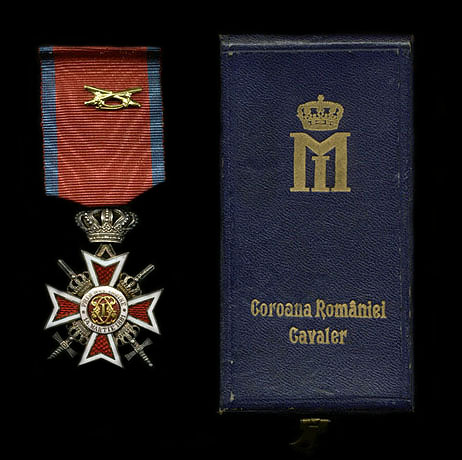
The military award shown above is the Order of the Crown, Knight grade with swords. Awarded for either military merit in time of peace or bravery in war. The cross is made of red enamel with white edges. The golden monogram of "King Carol" was placed in the center with the motto "Prin noi insine" (By ourselves alone) and date of institution inscribed in the outer ring. This cross is the 1932 pattern. The reverse in the center it shows the golden inscription indicating the date "10 Maiu" (10th of May) with the dates "1866" "1877" and "1881" inscribed in the outer ring. The crowns were placed between the arms of the cross. The cross is suspended and attached to the Romanian Royal Crown. The ribbon is red with blue edges worn on military awards. The cross came in a blue case with the golden monogram of Michael I and the inscription "Coroana Romaniel Cavaler." | |
|
� The Order of the Star, Knight Cross
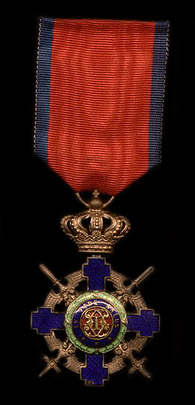

The Order of the Star of Romania shown above was officially instituted in May 1877. This Order is also in six Grades. The Order shown is the (1932-1947) version Knight Grade. The cross of this beautiful award is made of blue enamel. The center shows the golden monogram of King Carol surrounded by a green wreath, while between the arms of the cross show golden "Roman" style eagles with two swords crossing behind the eagles. The swords indicate that the recipient was given for bravery in the field. The Order has water marked red ribbon with two blue stripes at each end and two golden stripes shown in the outer edges. The reverse shows the date when the award was officially instituted although it has been in existence since 1864. The back of the ribbon shows a hook and clasp for attaching into uniform. A Unit or individual citation came with the award. Foreigners as well as Romanians were eligible although most of the foreign recipients were mostly Germans. | |
|
The Romanian medal for the Crusade against Bolshevism 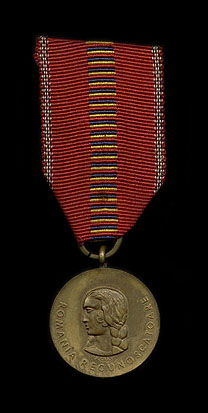
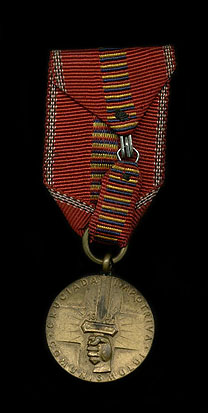
The Romanian medal for the Crusade against Bolshevism shown above was instituted on 1 April 1942 by decree no. 1014 from King Michel I and was awarded to all branches of the Romanian forces including Germans. The bars were used for soldiers who were in the Front-line. The medal is suspended by a dark red ribbon with white edges. The center of the ribbon shows in a lateral pattern the Romanian national colors red/yellow/blue. The obverse depicts the Romanian liberty symbol and the inscription "ROMANIA RECUNOSCATOARE." In addition, below the liberty head is the designers name "P. Grant" in small letters. The reverse shows a sword being hand held with the date "1941" and around the outer rim the legend "CRUCIADA IMPOTRIVA COMUNISMULVI" (Crusade Against Communism). The recipients of the award were also provided with small bronze or silver metal bars with the inscription of the region of the particular campaign that the Romanians fought. These campaign bars were placed on the ribbon. There were about (13) bars, the rarest being Stalingrad. Currently there exist reproduction medals, they do not have the small "P. Grant" inscription below the liberty head.
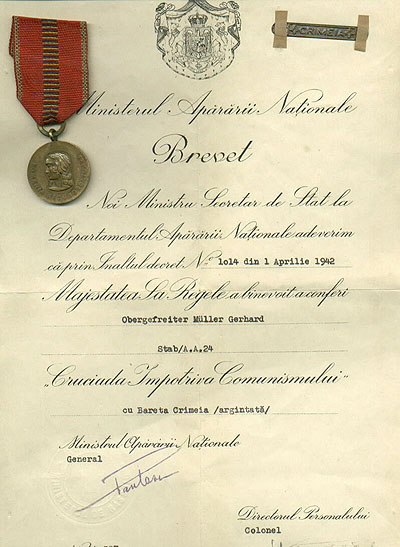
Shown above is a Romanian Crusade Award Document with Crimean Bar that was awarded to a German soldier. The Crimean campaign was one of the hardest battles that the Romanians fought, which amounted to loosing 40 percent of its combat strength. By early April 1944, Germans and Romanians were retreating towards Sevastopol for evacuation. Many Romanian mountain troops were used for rearguard actions against overwhelming odds while protecting the flank of the German V Corps. |